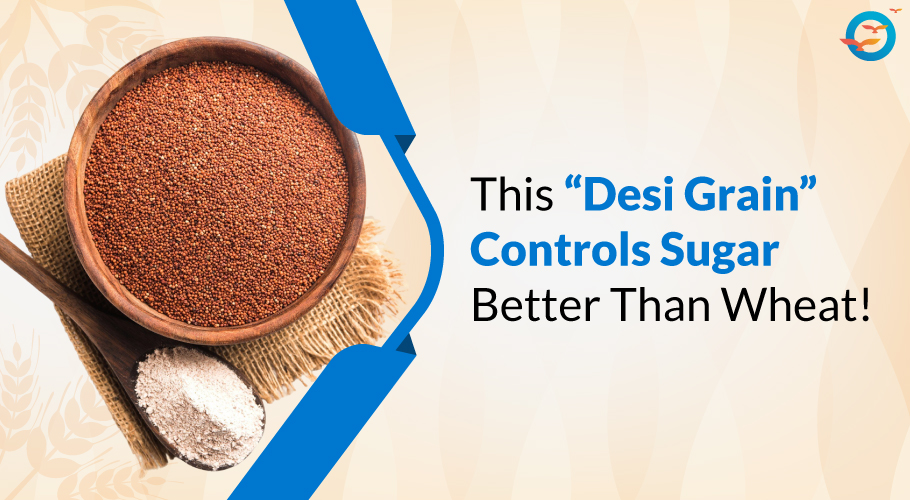Ragi and Its Role in Diabetes Management

What Is the Role of Ragi in Diabetes Management?
Managing diabetes starts with what’s on your plate. And in that journey, one ancient Indian grain Ragi, or finger millet is rapidly gaining popularity among health experts and diabetics alike.
But is ragi good for diabetes, really? Or is it just another trending health food?
Packed with fiber, rich in calcium, and gluten-free, ragi is more than just a staple from grandma’s kitchen. Backed by modern nutrition science, this humble millet is proving to be a powerful ally in sugar control. In this blog, we’ll uncover the real role of ragi in diabetes management, how it compares with other grains, and how you can use it safely and effectively in your daily meals.
Let’s dive in.
What is Ragi (Finger Millet)?
Ragi, or finger millet, is a traditional Indian grain with a long history in holistic nutrition. It’s a gluten-free whole grain that has earned superfood status due to its dense nutrient profile. For those wondering if ragi is good for sugar patients, the answer lies in its complex carbs and high fiber content, which lead to slower glucose release—essential for diabetes control.
Nutritional Profile of Ragi
Ragi’s nutrient density is what makes it stand out:
- Low Glycemic Index (GI): Slower rise in blood sugar
- High Fiber: Promotes satiety and regulates glucose absorption
- Rich in Calcium & Iron: Supports bone health and combats fatigue
- Gluten-Free: Ideal for those with gluten intolerance
- Contains Essential Amino Acids: Helps with cell repair and metabolism
These properties explain the multiple advantages of eating ragi, especially in a diabetic diet.
Glycemic Index of Ragi
The glycemic index (GI) measures how quickly a food raises blood sugar. Low-GI foods (below 55) are best for diabetes. Ragi has a GI of 54–68, depending on processing (whole vs. flour). While slightly higher than some other millets, it's still lower than white rice (~73), wheat flour (~70), and maize (~69).
Its relatively moderate GI, when combined with fiber and protein, makes it suitable for a balanced diabetic diet.
How Ragi Helps in Diabetes Management
Let’s answer this clearly: Is ragi good for diabetes patients? Yes. Here’s why:
- Stabilizes Blood Sugar: Thanks to fiber and polyphenols, ragi slows down digestion.
- Boosts Insulin Sensitivity: Helps your body use insulin more efficiently.
- Reduces Hunger Pangs: Great for weight management, which is critical for Type 2 diabetes.
- Improves Gut Health: The high fiber improves digestion, supporting better metabolic health.
These points support the ragi role in sugar control, especially when part of a balanced meal plan.
Scientific Studies and Evidence
A 2023 study published in the International Journal of Food Sciences found that diabetic individuals who consumed ragi-based meals had improved postprandial glucose levels compared to those who ate refined wheat or rice (PMC10560538).
Another clinical review in Nutrients 2024 emphasizes that finger millet and diabetes management go hand-in-hand due to its high polyphenol content and antioxidant activity.
Ragi vs. Other Millets/Grains
|
Grain |
Glycemic Index |
Fiber Content |
Gluten-Free |
|
Ragi |
54–68 |
High |
Yes |
|
Wheat |
~70 |
Moderate |
No |
|
White Rice |
~73 |
Low |
Yes |
|
Jowar |
~62 |
High |
Yes |
|
Bajra |
~55 |
High |
Yes |
|
Quinoa |
~53 |
High |
Yes |
Ragi stands out due to its versatility, affordability, and calcium content, making it ideal for diabetics looking for wholesome food alternatives.
How to Incorporate Ragi in a Diabetic Diet
Looking to try ragi flour for diabetes? Here are some easy options:
- Ragi roti: Pair with veggies or legumes
- Ragi dosa or idli: Use fermented batter to improve digestibility
- Ragi porridge: Sweeten naturally with stevia or dates
- Ragi upma or ladoo: Skip jaggery and sugar
Is ragi roti good for diabetes? Yes—but watch portions and always combine with fiber or protein.
Who Should Avoid or Limit Ragi?
While ragi is great for most people, there are some exceptions:
- Kidney patients: Due to high oxalates, ragi may not be ideal
- Excess consumption: Can cause thyroid issues in very high quantities
- Monotonous diets: Avoid using only ragi—variety is key
Expert Tips & Best Practices
- Balance with veggies and proteins for better glycemic control.
- Consume it earlier in the day for breakfast or lunch.
- Keep portions in check: A diabetic-friendly diet thrives on moderation.
Conclusion
So, is ragi good for diabetes? Absolutely. The benefits of ragi in diabetes include improved blood sugar control, better digestion, and more stable energy levels. But like all good things—moderation and smart pairing is key. Include ragi flour for diabetes in your meals, but always balance it with protein, fiber, and fats for best results.
Consult your healthcare provider or nutritionist before making major dietary changes.
FAQs:
Is ragi good for diabetes?
Yes, ragi’s fiber and moderate GI make it suitable for managing blood sugar levels.
Can diabetic patients eat ragi daily?
Yes, in moderate portions and when balanced with vegetables and proteins.
Is ragi roti safe for people with high blood sugar?
Absolutely, especially when cooked without oil and sugar.
Can I replace wheat flour with ragi flour in diabetes?
Yes, ragi is a great gluten-free alternative to wheat.
What is the glycemic index of ragi?
The GI of ragi ranges between 54–68 depending on how it’s processed.
Can ragi help in weight loss for diabetics?
Yes. Its fiber and satiety-promoting properties help in managing weight effectively.

